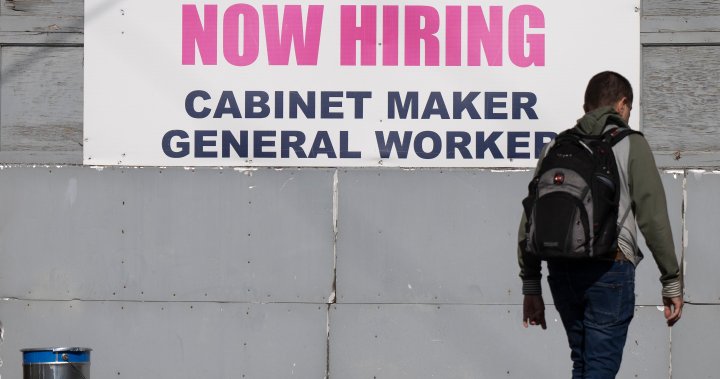Canadian companies have lost a step when it comes to innovation, experts say, pointing toward Ottawa having work to do to turn around stagnating business investment and an over-reliance on temporary workers.
It’s a problem that will push down wealth and prosperity in Canada if left unsolved, according to economists and innovation experts who spoke to Global News.
Canada’s economic growth has been fairly flat in recent months, but that’s largely thanks to an influx of immigration and non-permanent residents providing a boost to output. Without temporary workers, Canada’s real gross domestic product wouldn’t be as strong as it is. On a per-person basis, it’s been declining.
A drop in per capita GDP should be worrying to Canadians and policymakers, says Ben Bergen, president of the Council of Canadian Innovators, a group made up of more than 150 tech CEOs.
It’s this measure that reflects the prosperity and wealth of a nation, not just on an individual basis, but on a wider scale that generates revenues for critical social spending like healthcare.
“GDP per capita is kind of how much money is in your jeans pocket,” Bergen says.
The slowdown in the Canadian economy has been engineered to a certain degree by the Bank of Canada as it raised its benchmark interest rate to cool spending demand and tame inflation. But the decline in per capita GDP also reflects a lack of innovation in the economy, experts like Bergen say, as businesses fail to invest to produce more with less.
Productivity, the measure of GDP output per hour worked, is currently on a six-quarter slide, according to Statistics Canada. Experts who spoke to Global News recently pointed to a lack of capital stock for workers as driving down productivity.
Capital stock refers to anything from machinery needed to accomplish a task to research and development funding — anything that makes a job easier and more efficient to perform.
Canada has become a “laggard” compared to the United States and its other counterparts when it comes to business investment, says Randall Bartlett, director of Canadian economics at Desjardins.
The Canadian economy was doing well in capital investment at the turn of the century, Bartlett says, driven by spending in the energy sector to take advantage of a boom in gas prices. But as gas prices largely fell in the latter half of the last decade, so too did investment, both in the energy industry, specifically, and the broader Canadian economy.
“We really haven’t seen sectors rise to the top and take the lead in terms of driving investment and productivity and innovation since that time,” Bartlett says.
Instead of spending on research and development – investments in a business to improve production – employers have instead turned to new hires and, in particular, non-permanent residents to ratchet up their output, Bartlett explains.
Leaning on temporary workers as opposed to investing in “long-term, productivity-enhancing innovations” means businesses are failing to increase their outputs and failing to increase overall profitability and incomes in Canada, he says.
Leaning on immigration to boost business activity comes with a number of consequences. National Bank of Canada economists called this the “population trap” in a recent report, referencing the rapid run-up in population eating up all available capital spend and not leaving enough for quality-of-life improvements.
That report highlighted a new record in the housing deficit tied to rapid immigration, and an inability for Canadian developers to build quickly enough to restore housing affordability.
A Desjardins report from earlier this month also argued that maintaining the current pace of non-permanent resident admissions could keep pressure on inflation and “erode housing affordability further,” barring a rapid increase in the rate of new home construction.
Get the latest Money 123 news.
Sent to your email, every week.
Bartlett says there’s a “difficult balance to strike” in terms of meeting the labour needs of businesses and also generating enough per capita revenue to funding demands for spending on health care, infrastructure and other services that newcomers both feed into and lean on when they arrive.
Canadian business investment not keep pace is not necessarily the fault of employers, Bartlett notes. Businesses are bringing in labour from outside the country because they see it as a better use of their dollars to make a new hire than to invest it in their own operations, he explains.
“Borrowing costs and input costs are very high. So the cost of investment is extremely high right now with a very uncertain outcome,” Bartlett says. “It makes a lot more sense to bring in temporary labor on a short-term basis to meet potential short-term demand rather than making these big long-term investments.”
Bergen says that there’s a myth to explain the lack of R&D spending in Canada, which is that Canadian companies aren’t risk-takers.
Like Bartlett, he says that what’s keeping businesses on the sidelines of the innovation economy is the way investment promotion works via Canadian tax credits, regulatory frameworks and other policies.
“If you don’t have the right mechanisms in place, why would companies invest? If you’re going to invest $10 and only get $9 back, why would you make that investment as a company?” he says.
Bergen says the Canadian government has not adapted to the new reality of the global economy, which prioritizes the ownership of intellectual property (IP) over tangible assets. Jim Balsillie, the co-founder of Research In Motion, known as BlackBerry, published an op-ed in the National Post last weekend pointing to a lack of IP ownership as the big gap holding back Canadian firms from investing more.
While Canada has long been prominent as a nation rich in natural resources, Bergen explains the country needs to take ownership of those assets as opposed to just selling them off to other jurisdictions who add value and reap the rewards. The clearest example of this phenomenon is in the energy sector, where Canadian crude oil is more often shipped to refineries in the U.S. and converted into higher value products.
“If we actually want to fix productivity, we actually want to fix our decreasing GDP per capita, how do we move into the supply chain area where there’s actual value?”
Efforts to wake Canadian policymakers up to the realities of the new economy have yielded mixed results, Bergen says.
This month, the federal government is starting a review of the Scientific Research and Experimental Development (SR&ED) program, a key tax credit system that many Canadian firms rely on to fund innovation.
Bergen says that an overhaul of SR&ED, which costs roughly $3.5 billion annually according to C.D. Howe Institute, has been long overdue.
CCI has concerns about the proportion of firms receiving SR&ED that are “Canadian in name only,” or a multinational company that with Canadian operations such as IBM Canada. Federal programs that fund the foreign operations of giant firms are counter-intuitive to improving Canadian innovation, Bergen argues, adding policymakers could better allocate resources to encourage domestic business investment.
In a statement late last year announcing the SR&ED review, Ottawa said the goal of the program was to help Canadian firms “develop valuable intellectual property” and said the modernization would focus on how to use the tax credits to effectively position Canada “as an R&D leader.”
But in that same release came word of delay in implementing the Canada Innovation Corporation. First pitched in the Liberals’ 2021 election platform, the CIC was intended as a central innovation agency that could effectively direct the country’s economic development goals.
The late-year announcement said that the CIC’s implementation, and its integration with the Industrial Research Assistance Program (IRAP) – a key source of startup funding for early-stage firms – is now delayed to 2026 at the earliest. Bergen and the CCI believe the innovation agency is likely “dead,” with key stakeholders in the original formulation of the agency now moved on.
Finance Minister Chrystia Freeland has expressed continued interest in rolling out the CIC, but also in taking time to do it properly.
“We believe in the CIC, we believe in Canada we have to do even more to support productivity and innovation. … We want to be sure that we’re getting it right, that we’re building something that can deliver. And that’s what we’re going to do,” Freeland said at an event in Calgary in Dec. 20 when asked about the delay.
“We are committed to supporting Canada’s businesses and innovators,” Freeland’s press secretary Katherine Cuplinskas said in a statement to Global News on Friday. “That is why we are moving forward with the CIC, will be inviting Canadians to provide feedback on the SR&ED tax incentive program, and are ensuring the National Research Council IRAP can continue to seamlessly provide its essential support to the thousands of small and medium-sized enterprises it works with each year.”
Global News asked Finance Canada about how much SR&ED spending goes to firms that are “Canadian in name only,” but did not receive a direct response.
The CIC could have been a “lens” to focus Canada’s IRAP and eventually other R&D funding programs in the most productive direction, Bergen says. Rather than indiscriminately funding a host of startups, the CIC could have spotlit particular industries where Canada can excel and out-compete other nations.
Canada can encourage business investment with an industrial strategy, Bergen says, by lining up tax credits and other policies to sweeten the deal for firms in particular industries to invest in their own operations. He cites South Korea’s success developing expertise in semiconductors as the kind of case study Canada could learn from.
Bartlett argues that one area Canada ought to focus on is the green energy transition as an industry where the country can flex its natural advantages to boost business investment. That could be done through changing regulatory requirements to help get mines opened, or otherwise lowering the burden on firms to put their money into Canadian operations.
“We need to just generally focus on making it more attractive for businesses to make investments in Canada, as opposed to bringing in temporary labor to meet the demand,” he says.
Bergen says that it’s not too late to turn a corner on innovation in Canada, but without a wake-up call and quick action, Ottawa is unlikely to convince businesses that R&D investments are worth it.
“We will not continue to inherently be rich and a prosperous country just because that’s how it was in the past,” he says. “Realize that by missing the mark, we are continuing our downward slide … That’s something we definitely have to fight against. We have to get the right public policy measures in place in order to prevent that from happening.”




